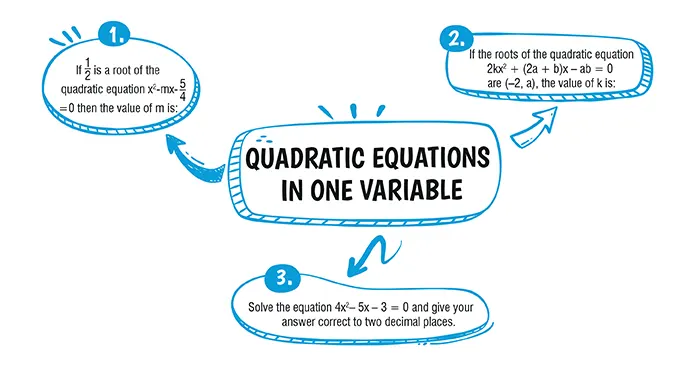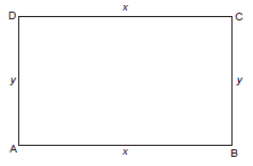Table of Contents

Ans. (b)-2
Explanation:
Given
x=\frac{1}{2} \\
\text{as root of the equation}\\
x^2-mx-\frac{5}{4}=0\\
\therefore \begin{pmatrix}\frac{1}{2} \end{pmatrix}^2-m \\
\begin{pmatrix}\frac{1}{2} \end{pmatrix}-\frac{5}{4}=0\\
\Rightarrow \frac{1}{4}-\frac{m}{2}-\frac{5}{4}=0 \\
m = - 2
Ans. (a) -1
Explanation:
2kx + (2a + b)x – ab = 0\\
\therefore \text{a is a root of this equation}\\
2ka + 2a + ab – ab = 0\\
2a(k + 1) = 0 \\
\therefore k = –1
Explanation:
Given the equation is,
4x– 5x – 3 = 0
Compared with ax+ bx + c = 0,
we have,
a = 4, b = – 5, c = – 3
\therefore x=\frac{-b\pm\sqrt{-4ac}}{2a}\\
=\frac{-(-5)+\sqrt{(-5)^2-4×4(-3)}}{2×4}\\
=\frac{5\pm\sqrt{25+48}}{8}=\frac{5\pm\sqrt{73}}{8}=\frac{5\pm8.544}{8}\\
=\frac{5\pm8.544}{8} \space or \space \frac{5-8.544}{8}\\
=\frac{13.544}{8}\space or \space \frac{-3.544}{8} \\
= 1.693 \space or \space – 0.443= 1.69 \space or \space – 0.44 \\ (correct to 2 decimal places) Ans.
Explanation:
Given equation is,
x^2 – 3 (x + 3) = 0 \\
⇒ x^2 – 3x – 9 = 0 \\
\text{On comparing the equation with} \\
ax^2 + bx + c = 0, \\
\text{we get,} \\
∴ a = 1, b = – 3, c = – 9 \\
b^2 – 4ac = (– 3)2 – 4 (1) (– 9)\\
= 9 + 36= 45 \\
x=\frac{-b\pm\sqrt{b^2-4ac}}{2a} \\
= \frac{-(-3)\pm\sqrt{45}}{2×1} \\
= \frac{3\pm3\sqrt{5}}{2} \\
x =\frac{3+3×2.236}{2} \space and \space \frac{3-3×2.236}{2} \\
x = \frac{3+6.708}{2}\space and\space \frac{3+6.708}{2} \\
x = \frac{9.708}{2} \space and\space \frac{3.708}{2} \\
x = 4·854 and x = – 1·854
∴ x = 4·9 and x = – 1·9 Ans.
Explanation:
Let ABCD be the rectangular garden and CD acts as his house compound wall.
Let Length AB = x m
Breadth BC = y m
According to the question,
xy = 200 ...(i)
x + 2y = 50 ...(ii)
From equation (ii), we get
x = 50 – 2y
Putting the value of x in equation (i), we get
(50 – 2y)y = 200
⇒ 50y – 2y^2 = 200 \\
⇒ 2y^2– 50y + 200 = 0 \\
⇒ y^2 – 25y + 100 = 0 \\
⇒ y^2– 20y – 5y + 100 = 0 \\
⇒ y(y – 20) – 5(y – 20) = 0
⇒ (y – 20)(y – 5) = 0
So, y = 5, 20

When y = 5, then
x = 50 – 2y
x = 50 – 2 × 5 = 40
When y = 20, then
x = 50 – 2y
= 50 – 2 × 20 = 10
So, dimensions of the garden are 10 m and 20 m or 40 m and 5 m. Ans.
Download Mind Map of this chapter
Download NowWant to Practice Mock Tests of this chapter
Practice NowDownload Important Questions of this chapter
Download Now| Chapter No. | Chapter Name |
|---|---|
| Chapter 1 | Goods and Service Tax (GST) |
| Chapter 2 | Banking |
| Chapter 3 | Shares and Dividends |
| Chapter 4 | Linear inequations |
| Chapter 5 | Quadratic Equations in one variable |
| Chapter 6 | Ratio and proportion |
| Chapter 7 | Factorization |
| Chapter 8 | Matrices |
| Chapter 9 | Arithmetic Progression |
| Chapter 10 | Geometric Progression |
| Chapter 11 | Coordinate Geometry |
| Chapter 12 | Reflection |
| Chapter 13 | Similarity |
| Chapter 14 | Loci |
| Chapter 15 | Circles |
| Chapter 16 | Constructions |
| Chapter 17 | Mensuration |
| Chapter 18 | Trigonometry |
| Chapter 19 | Statistics |
| Chapter 20 | Probability |
| Chapter Wise Important Questions for ICSE Board Class 10 Mathematics |
|---|
| Goods and Service Tax (GST) |
| Banking |
| Shares and Dividends |
| Linear inequations |
| Quadratic Equations in one variable |
| Ratio and proportion |
| Factorization |
| Matrices |
| Arithmetic Progression |
| Geometric Progression |
| Coordinate Geometry |
| Reflection |
| Similarity |
| Loci |
| Circles |
| Constructions |
| Mensuration |
| Trigonometry |
| Statistics |
| Probability |
CBSE Important Questions Class 10
ICSE Important Questions Class 10
CBSE Important Questions Class 10
ICSE Important Questions Class 10